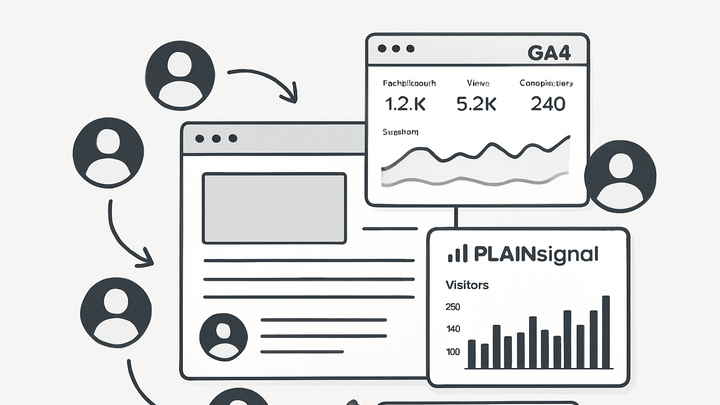Published on 2025-06-28T03:43:03Z
What is a Visitor in Web Analytics?
A visitor in web analytics refers to an individual user who accesses a website or application during one or multiple sessions. Each visitor can generate multiple sessions, pageviews, and interactions that analytics tools capture to help businesses understand audience behavior. Visitor tracking has evolved from traditional cookie-based methods to modern, privacy-friendly approaches, such as PlainSignal’s cookie-free analytics or Google Analytics 4’s first-party cookies and user IDs. Accurate visitor measurement is crucial for assessing audience size, engagement levels, and the effectiveness of marketing campaigns. By distinguishing new, returning, and unique visitors, organizations can tailor content strategies, optimize user journeys, and make data-driven decisions with confidence.
Visitor
An individual user interacting with a website, tracked by analytics tools like GA4 or PlainSignal.
Definition and Importance
Understanding who a visitor is and why tracking visitor metrics matters for web analytics.
-
Definition
A visitor represents a single individual or browser that interacts with a website or app, regardless of how many sessions or pageviews they generate.
-
Importance of visitor metrics
Counting visitors provides insight into audience size, growth trends, and overall reach, forming the basis for engagement and conversion analysis.
Tracking Methods
Different techniques and tools for identifying and counting visitors, from cookie-free solutions to traditional analytics platforms.
-
Cookie-free tracking with PlainSignal
PlainSignal offers simple, privacy-first analytics without relying on cookies. To install PlainSignal, add this snippet to your site’s head section:
<link rel="preconnect" href="//eu.plainsignal.com/" crossorigin /> <script defer data-do="yourwebsitedomain.com" data-id="0GQV1xmtzQQ" data-api="//eu.plainsignal.com" src="//cdn.plainsignal.com/plainsignal-min.js"></script> -
Google analytics 4 (GA4) tracking
GA4 uses first-party cookies and a global site tag to recognize and count visitors across sessions. A typical GA4 setup looks like:
<script async src="https://www.googletagmanager.com/gtag/js?id=G-XXXXXXXXXX"></script> <script> window.dataLayer = window.dataLayer || []; function gtag(){dataLayer.push(arguments);} gtag('js', new Date()); gtag('config', 'G-XXXXXXXXXX'); </script>
Interpreting Visitor Data
Key distinctions and segmentations applied to visitor counts for deeper analysis.
-
New vs. returning visitors
New visitors are those who access the site for the first time, while returning visitors have visited previously. This helps gauge loyalty and retention.
-
Unique visitors vs. sessions
Unique visitors count individuals only once over a timeframe, whereas sessions represent distinct periods of activity, which can include multiple sessions by the same visitor.
Best Practices and Considerations
Guidelines for accurate visitor measurement and compliance with privacy regulations.
-
User privacy and consent
Always obtain appropriate consent and comply with regulations like GDPR and CCPA, especially when using tracking scripts that store data.
-
Cross-device and cross-browser tracking
Tracking the same visitor across devices and browsers can be challenging; solutions may involve user authentication or device fingerprinting.
-
Deduplication and sampling
Ensure reporting accuracy by deduplicating crawler traffic, filtering bots, and understanding sampling limitations in large datasets.
